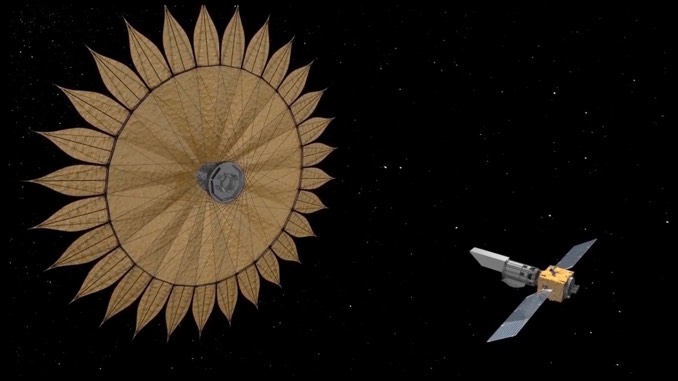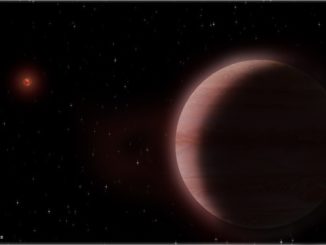
NASA engineers are studying the feasibility of a giant starshade that could be remotely positioned to block out a targeted sun, allowing a precisely positioned space telescope tens of thousands of kilometres away to directly image Earth-size exoplanets that otherwise would be drowned out in the star’s glare.
In the system currently being modelled, the starshade would unfold in space like a flower blossom, expanding to a diameter of 26 metres (85 feet) or so. The exoplanet-hunting telescope would be positioned up to 40,000 kilometres (25,000 miles) away. For the system to work, the two spacecraft would have to maintain their separation to within 1 metre (3 feet).
“The distances we’re talking about for the starshade technology are kind of hard to imagine,” said Michael Bottom, an engineer working on the project at NASA’s Jet Propulsion Laboratory in Pasadena, California. “If the starshade were scaled down to the size of a drink coaster, the telescope would be the size of a pencil eraser and they’d be separated by about 60 miles [100 kilometres].
“Now imagine those two objects are free-floating in space. They’re both experiencing these little tugs and nudges from gravity and other forces, and over that distance we’re trying to keep them both precisely aligned to within about 2 millimetres.”
Thousands of exoplanets have been found by studying slight changes in a star’s light as it is tugged ever so slightly from side to side by the gravity of an orbiting planet or by monitoring how a star’s light periodically dims when a planet passes in front of it as viewed from the vicinity of Earth.
But blocking out most of a star’s light would permit more direct observations like imaging and spectroscopic analysis of the constituents in an exoplanet’s atmosphere. A space-based starshade offers a potential solution that could lead to profound discoveries.
Bottom and JPL engineer Thibault Flinois are assessing technology gaps that need to be resolved before a starshade mission could be launched. One of those is making sure the separation distance, and the starshade’s orientation, can be precisely controlled.
The specifics of starshade missions depend on the size of the telescope. For the current study, the JPL engineers envisioned using a telescope the size of NASA’s proposed Wide Field Infrared Survey Telescope – WFIRST – with a 2.4-metre primary mirror.
Bottom wrote a computer program that would allow sensors to detect interference patterns caused by light leaking around the edges of a slightly-out-of-alignment starshade. Flinois and his colleagues then developed algorithms incorporating the alignment data to autonomously generate thruster firing commands to keep the starshade precisely aligned.
“We can sense a change in the position of the starshade down to an inch, even over these huge distances,” Bottom said.
Said Phil Willems, manager of NASA’s Starshade Technology Development work: “We use formation flying in space every time a capsule docks at the International Space Station. But Michael and Thibault have gone far beyond that, and shown a way to maintain formation over scales larger than Earth itself.”



